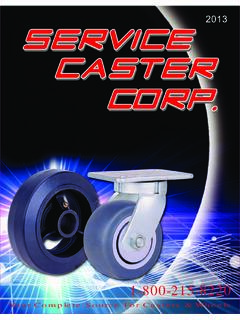Transcription of An Introduction to Hot Isostatic Pressing for Investment ...
1 Castings, the Introduction of liquid metal into a suitably shaped mold and then allowing it to solidify, is a way to produce net-shape metal components. Unfortunately, the liquid to solid phase change at the heart of the process is ac-companied by a change in volume, which is at the root of all the problems common-ly associated with the casting process. In the extreme cases, this volume change on solidifications gives rise to gross shrink-age cavities or hot tears within the cast-ing; this phenomenon is a problem for the foundry, but is well understood and can be corrected by a competent metalcaster, so that the end user of the casting need not usually take this problem into traditional methods of gating and feeding castings are the foundry-man s response to the volume change on solidification and represent an attempt to arrange for a liquid/solid interface to move through the metal in the mold cav-ity in such a way that defects in the cast-ing are minimized.
2 All the gross effects occurring within the gating and feeding systems which is then removed from the finished casting. Usually, micro-shrink-age still exists within the casting, weak-ening the material from within, but these age-old techniques result in a product ad-equate, and indeed often highly satisfac-tory for the applications in which castings are traditionally specified, structural and critical applications where a large safety factor can be designed into the Quality CastingsThe logical next stage to widen the application of castings is the removal of this residual micro-shrinkage.
3 The ap-proaches used involve the narrowing of the liquid/solid interface and control-ling the grain growth of the metal. Both techniques reduce micro-shrinkage by minimizing the restrictions within the so-lidifying casting. The ultimate narrowing of the liquid/solid interface occurs in di-rectional solidification and single-crystal technology, but this makes for extremely expensive castings, and traces of shrink-age can still occur between dendrite arms within the metal crystal as the last metal last metal to solidify is surround-ed by solid material, so that it cannot be fed from elsewhere, giving rise to shrink-age in the grain boundaries, and also to some extent, between dendrite arms within the grains.
4 This micro-shrinkage, expressed as a percentage of casting vol-ume, may be minute (less than .01%), but its effect on physical properties will be disproportionately high, because each tiny cavity is sharp-edged and often lo-cated in high energy areas of the compound the problem for the casting user, the feeding of the casting at this level represents a complex set of problems changing the level of hydro-static pressure within an environment (intergranular and ultimately interden-dritic). The net result is that the variation in properties between apparently identi-cal castings may be high, so that a safety factor must be , all castings may be said to have defects inherent in the process, and also to be inherently inconsistent in quality.
5 This is the reason for the aircraft industry s Casting Factor, requiring an overdesign (after other safety factors have been applied) for castings in air-borne the CastingPressure can be used to close internal defects in metal components, as in forg-ing. However, mechanical Pressing is not practical for the complex shapes of most castings. Hot Isostatic Pressing (HIP), on the other hand, involves gas pressure applied to the heated components. It can be applied with no change to the cast configuration, and when the pressure ex-ceeds the yield point, the internal shrink-age cavities will be forced closed and the metal will then diffusion bond, thus healing the is a well-established process for the improvement of a variety of materi-als such as titanium, cobalt-chrome, steel aluminum and superalloys for complex cast parts.
6 Rotating cast parts in aircraft engines, critical titanium castings and prostheses are examples of parts fre-quently processed by HIP. The closure of internal voids tends to improve mechani-cal properties, especially the notch-sensi-tive properties such as fatigue resistance and impact resistance. Defects visible by radiographic techniques can be elimi-nated. Most important, HIP processing makes the castings much more consistent An Introduction to Hot Isostatic Pressing for Investment CastersLEFT: Component before HIPRIGHT: Component after HIPP hoto compliments of Kovatch quality because the lower limit of the properties scatter band is involves batch processing in specialized expensive equipment, but the use of a HIP service provider removes the need for capital Investment , and us-ing the process can yield significant sav-ings in production costs.
7 For instance, the engineer designing the gating systems can concentrate on filling the mold with the simpler gating system, improving the casting yield and maximizing the number of castings to a mold. This in turn leads to lower finishing costs. Finally, the ne-cessity for radiographic inspection can be reduced or eliminated, resulting in even further Isostatic Pressing is unique in that it is the only known process which improves casting quality after the fact, in a predictable of HIP of Castings1. Improvement of mechanical proper-ties, particularly fatigue Allowing reduced gating and feed-ing.
8 Reduces casting costs by improving yield per mold as well as yield per pound of metal The ability to produce more consis-tent castings should open up new markets, enabling metal casters to compete with other manufacturing processes such forg-ing or Allowing the use of super-fine grain casting techniques. Several techniques are available for producing castings with extremely fine grain size, but the cast-ings are unusually difficult to feed. After HIP, the full advantage of the fine gained structure can be Inspection costs can be reduced, again due to the improved Enable the salvage of rejected partsThis article offered by Pressure Technology with input from Kovatch Technology HIP UnitHOT Isostatic Pressing Quality, Responsiveness & ReliabilityServing the Castings Industry for over 35 yearsWarminster, PA Concord.
9 OH Critical Requirements and Deadlines with Fast Tur naround Job After Generation Oil & GasBiomedicalAutomotiveElectronicPr ecision CastingPowder MetallurgyDiffusion Bonding





